Related Research Articles
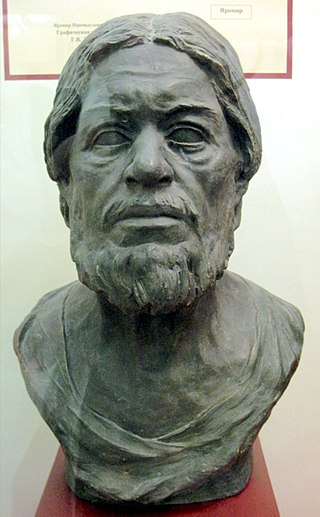
Samuel was the Tsar (Emperor) of the First Bulgarian Empire from 997 to 6 October 1014. From 977 to 997, he was a general under Roman I of Bulgaria, the second surviving son of Emperor Peter I of Bulgaria, and co-ruled with him, as Roman bestowed upon him the command of the army and the effective royal authority. As Samuel struggled to preserve his country's independence from the Byzantine Empire, his rule was characterized by constant warfare against the Byzantines and their equally ambitious ruler Basil II.

Geoffrey of Monmouth was a Catholic cleric from Monmouth, Wales, and one of the major figures in the development of British historiography and the popularity of tales of King Arthur. He is best known for his chronicle The History of the Kings of Britain which was widely popular in its day, being translated into other languages from its original Latin. It was given historical credence well into the 16th century, but is now considered historically unreliable.

Cunedda ap Edern, also called Cunedda Wledig, was an important early Welsh leader, and the progenitor of the Royal dynasty of Gwynedd, one of the very oldest of Western Europe.
Pir was a legendary king of the Britons according to Geoffrey of Monmouth's History of the Kings of Britain. He came to power in 125BC.

The Kometopuli dynasty was the last royal dynasty in the First Bulgarian Empire, ruling from ca. 976 until the fall of Bulgaria under Byzantine rule in 1018. The most notable member of the dynasty, Tsar Samuel, is famous for successfully resisting Byzantine conquest for more than 40 years. Sometimes the realm of the Cometopuli is called Western Bulgarian Kingdom or Western Bulgarian Empire.

Samuil Yakovlevich Marshak was a Soviet writer of Belarusian Jewish origin, translator and poet who wrote for both children and adults. He translated the sonnets and some other of the works of William Shakespeare, English poetry, and poetry from other languages. Maxim Gorky proclaimed Marshak to be "the founder of Russia's (Soviet) children's literature".
Sawyl Penuchel or Ben Uchel, also known as Samuil Penissel, was a British king of the sub-Roman period, who appears in old Welsh genealogies and the Welsh Triads.
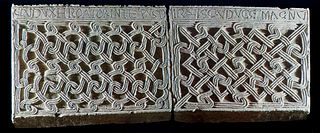
Stephen Držislav was King of Croatia from AD 969 until his death around 997. He was a member of the Trpimirović dynasty.
Svetoslav Suronja, was King of Croatia from 997 to 1000. A member of the Trpimirović dynasty, he reigned with the help of his ban, Varda. John the Deacon called him "Surinja", adopted in Croatian historiography as "Suronja", meaning "dark man" or "cold man", probably due to his temper. He was the oldest son of king Stephen Držislav, from whom he received the title of duke, and was designated as his successor.
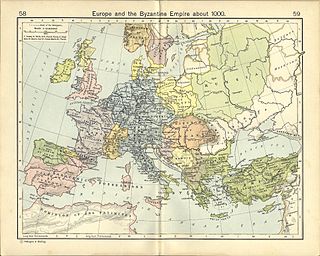
Gojslav was a monarch who co-ruled the Kingdom of Croatia with his brother Krešimir III from 1000 to his death in 1020. He was the youngest son of the former Croatian King Stjepan Držislav and a member of royal House of Trpimirović.
The Moscow Philharmonic Orchestra is an orchestra based in Moscow, Russia. It was founded in 1951 by Samuil Samosud, as the Moscow Youth Orchestra for young and inexperienced musicians, acquiring its current name in 1953. It is most associated with longtime conductor Kiril Kondrashin under whom it premiered Shostakovich's Fourth and Thirteenth symphonies as well as other works. The Orchestra undertook a major tour of Japan with Kondrashin in April 1967 and CDs of the Japanese radio recordings have been made available on the Altus label.

Gheorghe Șincai was a Romanian historian, philologist, translator, poet, and representative of the Enlightenment-influenced Transylvanian School.

The Battle of the Gates of Trajan was a battle between Byzantine and Bulgarian forces in the year 986.

The Battle of Spercheios took place in 997 AD, on the shores of the Spercheios river near the city of Lamia in central Greece. It was fought between a Bulgarian army led by Tsar Samuil, which in the previous year had penetrated south into Greece, and a Byzantine army under the command of general Nikephoros Ouranos. The Byzantine victory virtually destroyed the Bulgarian army, and ended its raids in the southern Balkans and Greece. The major historical source on the battle comes from Greek historian John Skylitzes whose Synopsis of Histories contains a biography of the then-reigning Byzantine Emperor, Basil II.

The Battle of Thessalonica occurred in 995 or earlier, near the city of Thessalonica, Greece. The battle was part of the long Bulgarian–Byzantine war of the late 10th and early 11th centuries. The Bulgarians under their ruler, Tsar Samuil, succeeded in ambushing and destroying the Byzantine garrison of Thessalonica, killing its commander, Gregory Taronites, and capturing his son Ashot.
The Battle of Strumica took place in August 1014, near Strumica, present-day North Macedonia, between Bulgarian and Byzantine forces. Bulgarian troops under Emperor Samuil's son Gavril Radomir defeated the army of the governor of Thessaloniki, Theophylactus Botaniates, who perished in the battle. After his death the Byzantine Emperor Basil II was forced to pull back from Bulgaria and was unable to take advantage of his success in the recent Battle of Kleidion.
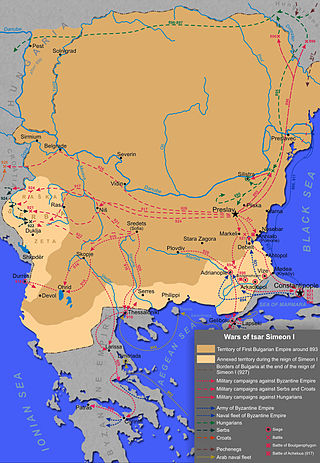
The Croatian–Bulgarian Wars were a series of conflicts that erupted three times during the 9th and 10th centuries between the medieval realms of Croatia and Bulgaria. During these wars, Croatia formed alliances with East Francia and Byzantium against the Bulgarian Empire.

Samuil Micu Klein was a Romanian Greek-Catholic theologian, historian, philologist and philosopher, a member of the Enlightenment-era movement of Transylvanian School. He is the author of Elementa linguae daco-romanae sive valachicae, a book which is the reference point for the start of Modern Romanian language period.
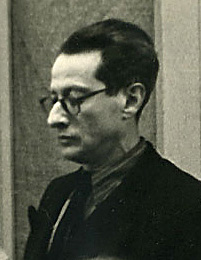
Samuil Grigorievich Nevelshtein was Soviet Russian painter, watercolorist, graphic artist, and art teacher, lived and worked in Leningrad, regarded as one of the representatives of the Leningrad school of painting, most known for his portraits of children and youth.

The siege of Zadar in 998 was part of the third Croatian–Bulgarian war and one of the last military conflicts between Croatian forces of King Svetoslav Suronja, supported by Venice and the Byzantine Empire, and the army of Emperor Samuil, who launched a large-scale Bulgarian military campaign against the Kingdom of Croatia.
References
- ↑ National Library of Wales, Welsh Classical Dictionary, page 650
- ↑ Monarchie Nobelesse website, Bretons
- ↑ History of the Kings of Britain 3.19 at Wikisource. Lewis Thorpe's translation for Penguin Classics (p. 105) gives two kings following him, Samuil followed by Penessil.